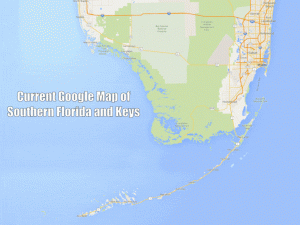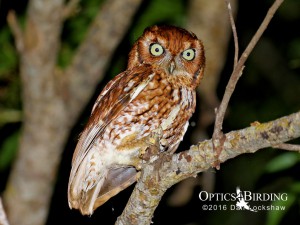
Eastern Screech-Owl is about the same size as an European Starling (same length and 2/3 the weight)
Southern Florida and the Everglades is home to five different species of owls. We decided to take a trip to Sothern Florida and search for the owls in the Everglades and upper Keys. North America has twenty species of owls. The Eastern Screech-Owl is the only owl species that is resident only east of the Rockies. It would be the primary owl of our searches. Barred Owl, rare in the west, would be our second target. With a new upcoming release of our sister Owling.com website, Optics4Birding sent me off to the east coast to document the owls in the Everglades. It’s a tough job but someone has to do it!
The Journey
I took a red-eye flight from Southern California on Thursday 4-28-2016. The flight arrived in Miami in the early morning the following day. After getting out of the airport, my first priority was to get a couple hours of rest in Homestead. Next, I would scout the area. It was near the entry to the southern portion of the Everglades.
I had four nights to search for owls. We spent our first two nights in southern Florida searching for the owls in the Everglades. We would then spend one night searching in the northern Keys. My final night I would search the northern portion of the everglades. Dr. Milad Hedayat, a longtime friend, would join in my searches. He joined me for the first three nights searching for the owls in the Everglades and Northern Keys. We spent our days scouting the areas and habitats while planning our night-time owling destinations.
The Southern Everglades
State Highway 9336 goes into the Southern Everglades. Tourists travel and visit this area more than any other in the Everglades. This road runs about 40 miles through the southern Everglades. It starts at the Ernest Coe Visitor Center just inside the eastern boundary. It continues south-west to the Flamingo Campground at the south-western side of the Everglades. Along the way there are multiple turnoffs to the most commonly visited attractions of the Everglades. We would begin our searches for the owls in the Everglades along this route.
Our first destination would be the Royal Palm Visitor Center and Anhinga Trail. Heading west from the Ernest Coe Visitor Center the turn off is about two miles. From there about two miles south is the Royal Palm Visitor Center.
Barred Owls in the Everglades at Royal Palm Visitor Center
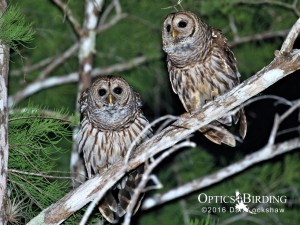
Looking at these Barred Owls you can see that the owl on the right is smaller than the owl on the left. The smaller owl is the male and the larger owl is the female. You can distinguish male and female owls also by voice (females usually have a slightly higher pitch). If they happen to be sitting next to each other size is a good way to distinguish the sexes.
As the sun set we could immediately hear several Barred Owls calling from the parking lot. A couple of squeaks and in a blink of the eye in came 2 adults. Let me be clear, these are extremely aggressive owls. Most of what I do is in complete darkness. I will only use lights to take a picture when an owl flies in to me.
Caution
In the case of these Barred Owls they are really bold and very dangerous. They have large sharp talons and can take out your eyes. Squeaking like a mouse in the darkness, I was almost owl food! In one of our recent posts we took An Excursion into the Eastern Sierras to look for Long-eared Owls and I had been attacked by one but these Barred Owls were way more aggressive and larger. I now have a clear picture in my mind of Barred Owl talons, inches from my face, coming in out of the darkness. The Barred Owls have attacked visitors in the Everglades while playing recorded calls. This is not legal to do in the park.
Next while still in the Ernest Coe parking lot, in flies a baby Barred Owl. Very cute but equipped with his parents very large talons. After taking pictures and some video we decided to take a look along the trail and listen for Eastern Screech-Owls. The Gumbo Limbo Trail had good habitat but we decided that it would not be wise to attract Eastern Screech-Owls with all the Barred Owls around, so we headed out. I have seen reports of them here.
Eastern Screech-Owl near Royal Palm
About a mile back out from the visitor center towards the main road (Highway 9336) was a left turn that we had passed and seen some interesting habitat and thought we’d take a look to see if we could find Eastern Screech-Owl. Scouting along this road and stopping in likely habitats we found multiple Eastern Screech-Owls. My impression was that they were very timid. Much more so than the Western Screech-Owl.
We spent the remainder of our evening looking in this area for Eastern Screech-Owls. Both color forms (red and brown) were present although it seemed that the red form was slightly more abundant. Thick areas with taller vegetation produced the most owls. Very difficult to find these small owls in these types of places. We had not made it very far on our first evening searching for the owls in the Everglades but we did find what we came looking for and we still had another night to look further along into the Everglades.
Great Horned Owl at Ernest Coe Visitor Center
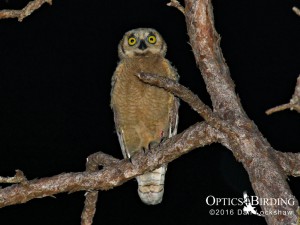
A juvenile Great Horned Owl. His large size, black bill, and yellow eyes make him immediately distinguishable. Those Big talons are really apparent even on this young owl.
Starting our second evening we decided to make a quick stop at the Ernest Coe Visitor Center. A young owl was screeching behind the visitor center. The vegetation around the visitor center is very dense and this owl was just back far enough that we could not see it. The screeches of young owls can be deceptive. We decided to put the efforts into seeing what young owl this was.
Since we were not certain what species of owl was screeching, we spent the time to find it… which was not easy. I certainly did not need to fly across the country to see a young Great Horned Owl in the Everglades. We never did hear or see the adults but the young owl was screeching up a storm.
After two hours of trying to get a sighting of the youngster we finally got brief views of him and took photos. With a fresh comparison in my mind of the Barred Owl, the size difference of this species was impressive. Don’t know why we never heard adults and this owl was young enough that it would have to have still been under adult care. It had blood on its leg and upper chest. Something had happened to this young owl to hurt it. This goes down as a “hmmm, very interesting”, no adults we heard or saw, and a young owl making a blazing racket.
Mahogany Hammock
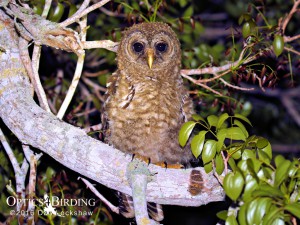
A juvenile Barred Owl is readily distinguishable with his dark brown eyes and yellow bill. This would not be as simple to identify if Spotted Owls were present as can be the case in the Western US (both species could be in the same place). In the Eastern US this is the only larger owl with dark eyes.
Driving in deeper now into the Everglades we headed for Mahogany Hammock. Coming into the parking area you could hear multiple Barred Owls. My impression of these owls is that they are just fearless and should be treated with real respect. Another pair of Barred Owls were here with a youngster. In more than one of our encounters we walked right up to both adult and juvenile owls of this species. To our surprise both adults and juvenile owls at this location landed on very low branches. In some instances, we approached close enough that we were within inches reaching out and touching the owls. They didn’t seem interested in us. They are obviously accustomed to people. My guess is that they also have a very healthy bite. Getting this close and taking pictures was good enough for us.
Since we had taken good photos of six or seven Barred Owls on our first two nights in the Everglades, it was time to focus our attention on the screech-owls a bit more. The Barred owls were certainly impressive to me since we see so few of them in the west. I was not as familiar with them as I am now. We spent the rest of our evening exploring along the remainder of the main road heading to Flamingo. Again it was a very productive and an exciting owling adventure.
Eastern Screech-Owl in Key Largo
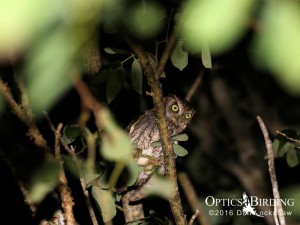
Finding the small Eastern Screech-Owl in very heavy cover often proved very challenging. In many cases we saw them while looking in through thick habitat… and they blend in very well.
On our third and final night owling together, Dr. Hedayat and I decided to try out the northern keys for Eastern Screech-Owl. Scouting in the daylight we went maybe half way down the keys but decided our best chances of getting away from people might be on the north portion of Key Largo. The keys are very narrow and getting away from car sounds is a bit trickier. The closure of natural areas didn’t help either.
After scouting down the keys we headed back north and tried our luck above the highway 1 bridge in any area we could get access to. Pulling off along any road we could along highway 905 above where the Highway 1 comes onto Key Largo we found several Eastern Screech-Owls. Hearing them and seeing them is very different things though.
The red color morph appeared slightly more prevalent in our searches although for such a brief glimpse of any area I would not make any claims. We heard many more owls than we saw and did manage to take photos of both color phases. In thick habitats with very active small owls this is more difficult than you might think.
The Northern Everglades and Big Cypress National Preserve
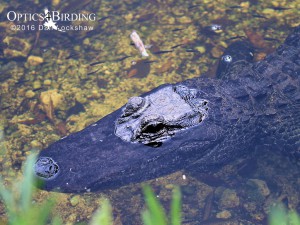
The alligators were very fascinating as long as they didn’t jump out of the water and eat me at night!
My final evening in the Everglades was spent in the north. Milad (Dr. Hedayat) had gone back to work at his hospital job and I went into the northern Everglades / Big Cypress National Preserve west of Miami. Hoping that no alligators would grab and eat me while out on my own squeaking in bushes along the swamps at night, I tried what turned out to be one of my favorite areas.
About 40 miles west of Miami on US 41 is the turnoff to county road 94. This road makes a big loop and eventually comes back out onto 41. Along this road at night were several Barred and Eastern Screech-Owls of both color phases. During the daytime was also extremely interesting with abundant wildlife. This area was an excellent destination relative to our post about the owls in the Everglades, easily accessible, and a very fascinating place.
Burrowing Owl in Brian Piccolo Park
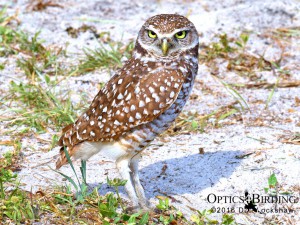
The Florida Burrowing Owl is a different race than the Burrowing Owls we see in the Western US, Mexico, and Southern Canada.
On my final morning before flying out of Fort Lauderdale I figured I’d make a stop by Brian Piccolo Park that was not too far from the airport and see if I could quickly find any Burrowing Owls. I had seen reports of them there but with very little time I knew I was pushing my luck. Although having only about a half hour to spare the owls were easy to find.
The Florida race of Burrowing Owl is distinct from its western cousins in the fact that it digs its own hole. The owls in the Western US, Mexico, and Southern Canada only enlarge existing burrows. Ground squirrels or prairie dogs had originally dug these burrows.
Range
Although the Florida Burrowing Owls do not appear to have the seasonal migratory movements we see here in the west, it does appear that this race has moved north into the southern portions of Georgia, east into the Bahamas and maybe south into Cuba. Here in California there are some reasonable level of movements in most places although where food sources are abundant some portion of the owl population may be sedentary or non-migratory.
The populations of Burrowing Owls in Florida are scattered and as a result of the loss of habitat have moved from their historic ranges in the prairies of Central Florida. Habitat changes have caused the owls to relocate to more coastal areas such as drained wetlands and cleared areas that were previously forested. They are often found in vacant lots or city parks, as were the one’s pictured here.
The few owls that I had the opportunity to see were certainly habitualized to people and showed no fear or interest in my taking photos of them. The Burrowing Owls are classified as a species of special concern in Florida.
The Future of the Everglades and Florida Keys
As a closing note some comments on the future of this area is appropriate. This is a very large topic and certainly the increase in global temperature and rise in sea level is now fairly universally accepted by science as being induced by mankind. Most of the Everglades (and the Florida Keys) sit at very low elevations above sea level.
The United Nations created an intergovernmental panel to evaluate the effects of climate change. Their 2013 predictions were that ocean levels would rise by 1 to 3 feet by the end of this century but the uncertainties were significant and the actual increase could be much more. Included here is a map that depicts a 3-foot rise in ocean level. At this rise in sea level a large portion of the Everglades and Keys are going to be underwater. Salt water will destroy most of the life here including the owls in the Everglades.
As both people and wildlife are being forced to move, with a declining land area, there isn’t any question who will lose. Our era is projected to experience the largest mass extinction of species this planet has ever seen, with more species expected to go extinct in our lifetimes than when the asteroid hit earth 65 million years ago.
Optics4Birding hopes that more people will become involved and interested in nature. The biodiversity of earth makes our home a jewel. Go see nature, it is a magnificent place.

